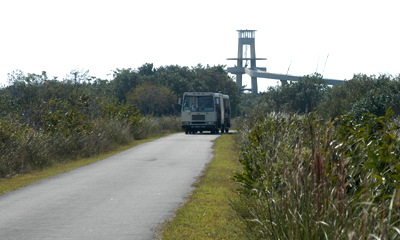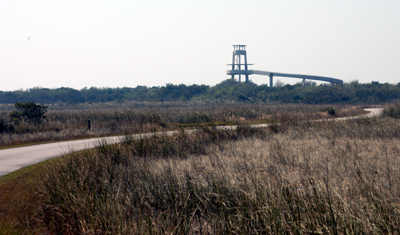
Bicycling gives visitors close-up look
SHARK VALLEY, Fla.— When you were a child, you probably never listened to the old folks who would tell you to be careful of bumps in the road when riding a bike, because the bumps always made bike riding so much fun.
In childhood, those bumps were big branches and broken chunks of sidewalk you would grasp your handlebars and trample over.
At Shark Valley on the northern border of Everglades National Park, those bumps are lazy alligators and a big reason you should finally accept the advice of your elders.
Two-wheelin’ along the 15-mile round-trip, paved tram road through Shark Valley’s endless, serene, swaying, sawgrass prairie, you’re likely to see dozens of dark, creepy creatures staring right back at you, wearing what appears to be a grin. They lay right on the road or in the canal that parallels the road.
 |
A family leaves for a weekend ride at the bicycle rental area at Shark Valley, near the Visitor Center (Staff photos). |
You’re out in gator country now and there are no short cuts to the end
You could turn your bike around, but then you’d be missing out on a great way to get a unique glimpse of wilderness in this river of grass that far outweighs any fretfully frightful, leg-cramping, sore-butt, bad weather blues.
To get the most out of your glide through the glades, call ahead and make reservations to be led by a park ranger. Saturday at 10 a.m. is the only time for the free ranger-led bike tour, but it’s well worth it to accommodate your schedule to that day and time. The three-hour tour offers a good pace to peddle and provides insightful information.
 |
Riders leave the bicycle rental hut at Shark Valley. |
But if you go on your own, start behind the visitor center and follow the straight West Road. The loop will take between two to three hours to complete.
If you go on the bike tour, the friendly and enthusiastic Daniel Martin, a.k.a. Ranger Dan, may lead you.
“Right now you are standing on a 25-mile wide river of grass,” Ranger Dan said. “Shark Valley is the heart of the Everglades.”
In this heart of the Everglades where alligators roam free, the chance of survival for their tiny tots are very slim.
“Out of 20 eggs, only about two will live to be adults,” Ranger Dan said. “The eggs are eaten by other alligators, raccoons, great egrets and great blue herons, the largest wading bird here.”
 |
Alligators swim along the canal that borders portions of the Shark Valley road. |
Tropical black vultures, temperate turkey vultures, snow egrets, Brazilian anhingas and Argentine wood storks are just a few of the birds seen and heard throughout Shark Valley.
“Do all alligators eat birds?” Boca Raton resident Anne Gillman asked.
“Oh yeah, they’ll eat anything,” Ranger Dan said. “They’d make a great garbage disposal.”
Four small artificial lakes called borrow pits are along the route. These artificial “gator holes” are areas where crushed limestone was removed to raise the level of the tram road.
The gator holes get filled with water and during the winter months from November through April, when the rest of the prairie is dry, these borrow pits act as watering holes for a variety of animals,” Ranger Dan said.
Don’t expect to see sharks at Shark Valley, which has neither sharks nor a valley, and don’t expect to see otters at Otter Cave Hammock Trail along the Shark Valley tram road, which no longer has otters and is not a cave.
The short walking trail is strewn with tropical trees such as gumbo-limbos, cabbage palmettos and coco plums. Holes make the ground look like Swiss cheese, ranging from two to 10 inches wide.
 |
The bicycle trail at Shark Valley runs along a canal filled with wildlife. |
“Be careful of the holes on the limestone rock path,” Ranger Dan said. “You could fall right in.”
“Walking through this is like walking through the West Indies,” Neil Lankey of South Carolina said.
Back on the main road, you’re more than likely to confront a couple of large motor vehicles filled with tourists who wave as they pass by. These are the trams and they have the right of way. Simply come to a complete stop and pull your bike off to the right when one approaches.
The speed limit on the road is 25 miles per hour and bicycles are subject to the same rules and laws as motor vehicles.
“Alligators have been clocked at 20 miles per hour on land,” Ranger Dan said.
A good reason to take it nice and easy when on a bike is that what may appear to be another alligator dropping may turn out to be a three-inch long baby snapping turtle.
Don’t let the turtle beat you to the one-mile increments painted on the road that tell you how many miles you have traveled.
 |
At left, a tram near the Observation Tower. |
The only obstacle may be the alligators that are lying on the path up to it. Some visitors timidly walk past four sprawled-out gators while others get as close as they possibly can to snap pictures.
Once you reach the top of the tower, you’ll be rewarded with a panoramic view of the sweeping landscape that tends to ease the burning sensation you may feel in your legs by now. You can see alligators wading in shallow waters, birds adrift on colorful wings and tropical hardwood hammocks that dot the sawgrass prairie. This is the perfect opportunity to take photos to show the folks back home.
The remaining eight miles bring even more bumps in the road, looking back at you while soaking in the afternoon sun. But by now you’ve lost the fear factor and dare them to chase you to see whether that five-mile per hour speed limit difference will actually give you a good advantage over the gators.
If you venture down by the creek, you could see an apple snail.
 |
Approaching from the east tram trail, the Observation Tower and pedestrian ramp dominate the southern sky. |
The pink, prickly flowers along the creek are fittingly called thistles. Stop to feel the texture of a blade of sawgrass.
“When you run your fingers along it upward, it’s smooth, but when you go downwards, it’s rough on the sides,” Ranger Dan said.
What looks like a miniature lobster hobbling along the side of the road is called a crayfish. What look like miniature flamingos wading in the nearby waters are roseate spoonbills.
By the time you reach the 15-mile marker, you feel like you’re in tune with nature and a sense of accomplishment overcomes you, until you meet Miami resident Adoney Bergamaschi, 76, who asks how many laps you’ve biked and you proudly say 15, mistaking “laps” for “miles.”
“I come out here every weekend and do up to 90 miles,” he said. “I started coming out here 25 years ago. It’s beautiful, totally natural. The only thing that’s man-made is the parking lot and the tram road.”
You look at him in amazement and wonder how many bumps in the road he’s had to peddle around.
If You Go
- Directions: Take the Florida Turnpike to the exit for SW Eighth Street (also known as U.S. 41 and Tamiami Trail). Travel 25 miles west on U.S. 41 to signs marked Shark Valley. From the Naples area, take U.S. 41 for approximately 60 miles east to signs marked Shark Valley.
- Hours: Shark Valley is open daily from 8:30 a.m.- 6 p.m. The Visitor Center is open daily from 8:30 a.m.- 5:15 p.m. The parking lot is free and closes at 6 p.m. daily.
- Admission fees: $8 per vehicle and $4 per pedestrian or cyclist.
- Rentals: Bike rentals are available from 8:30 a.m.- 3 p.m. and must be returned by 4 p.m. State law requires that children 16 and under wear helmets. Helmets may be rented at the tram office.
- Food: Bring food and water with you, there is no food for sale at Shark Valley.
- Comfort: Bring sunscreen and bug repellent. Mosquitoes are very active during the humid summer months.
- Contact: Call 305-221-8776 for general information about Shark Valley and to make ranger-led reservations or visit http://www.florida-outdoors.com/9tramroad.htm.

Comments are Closed